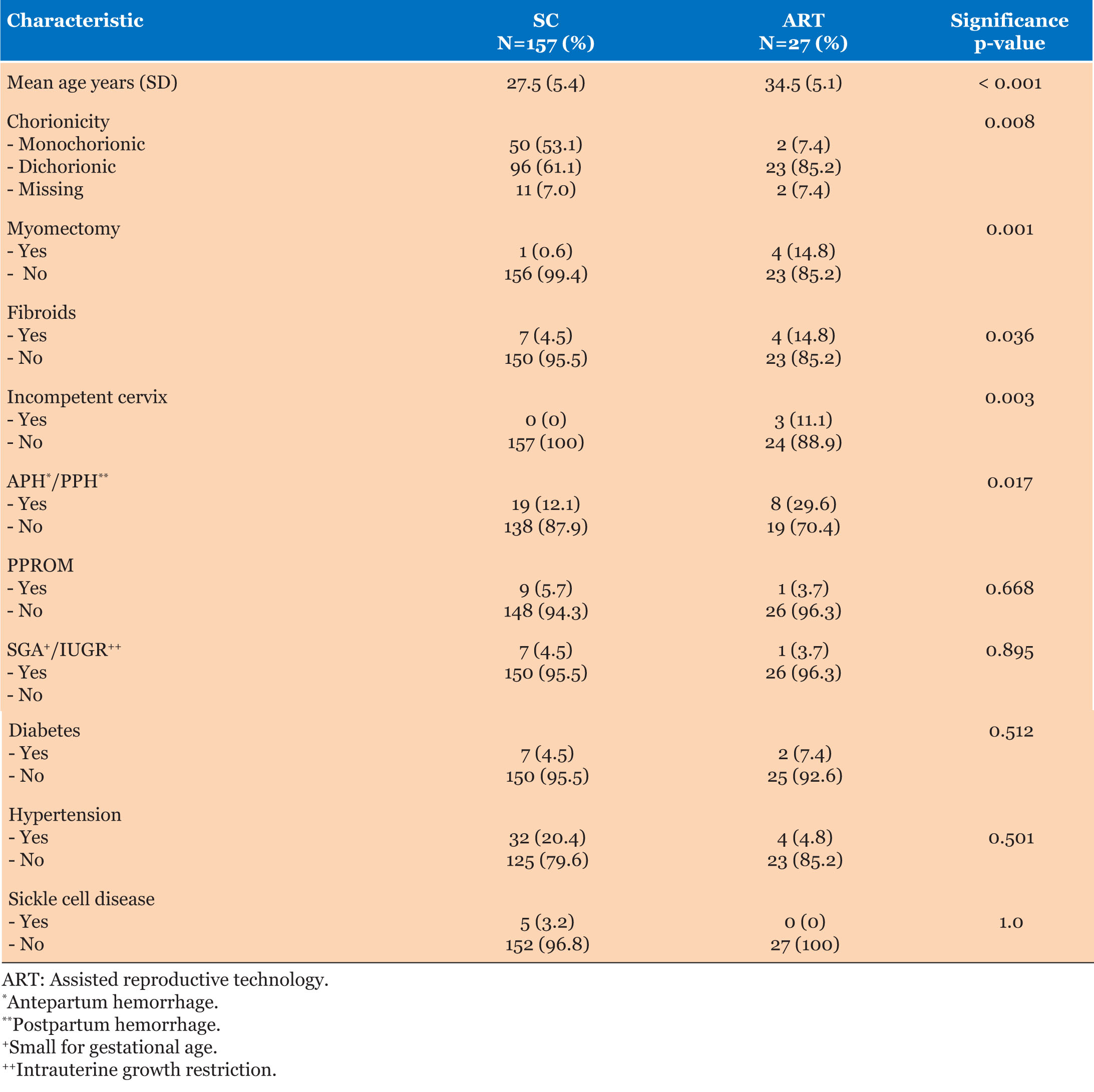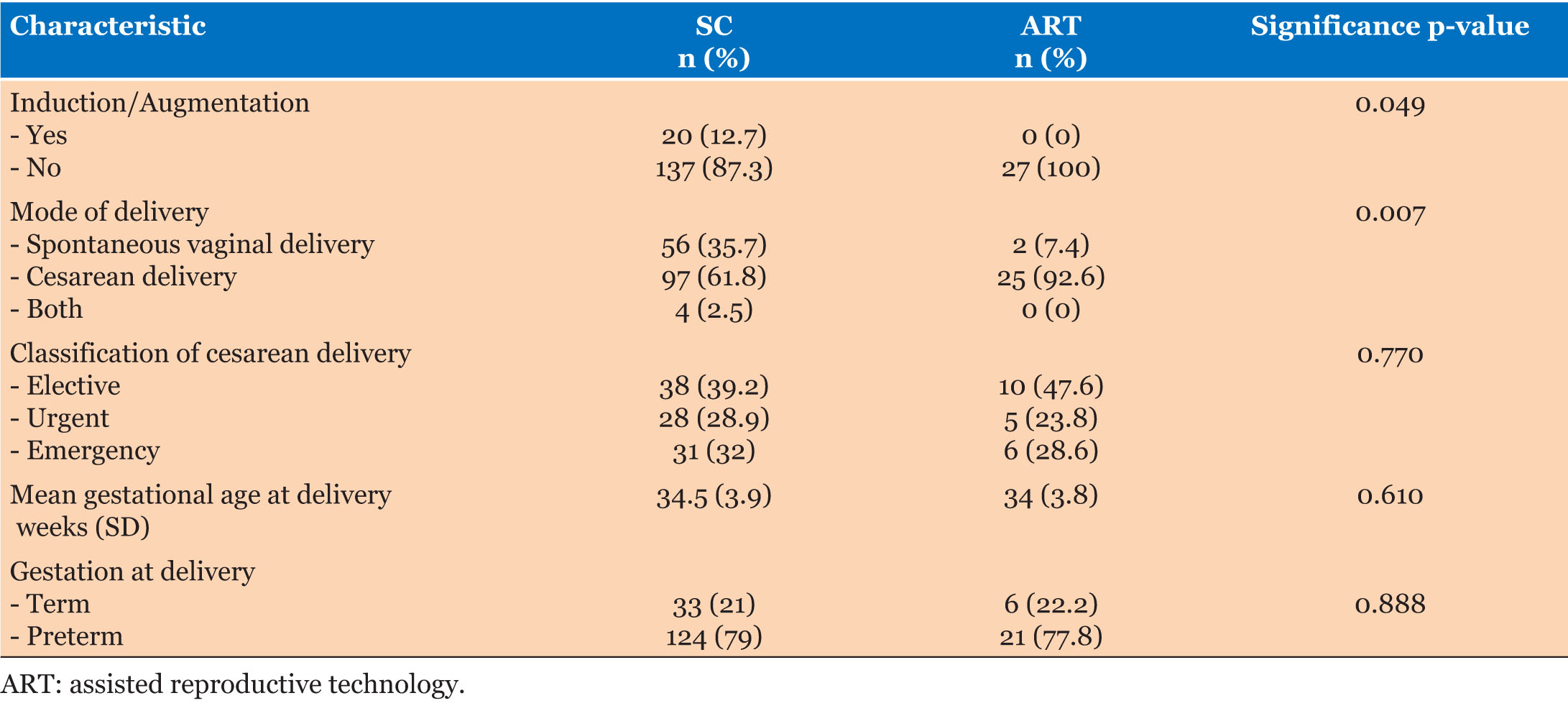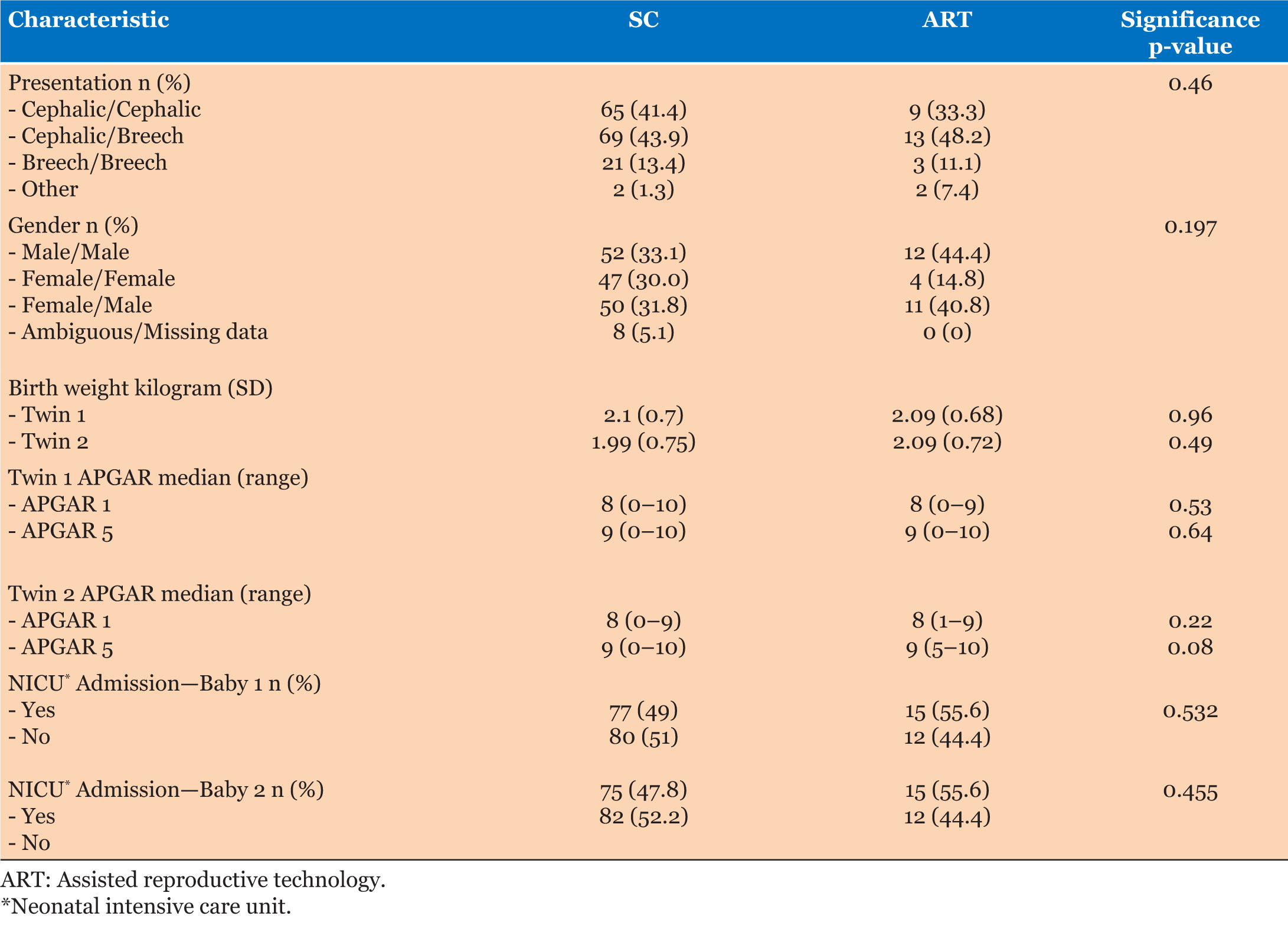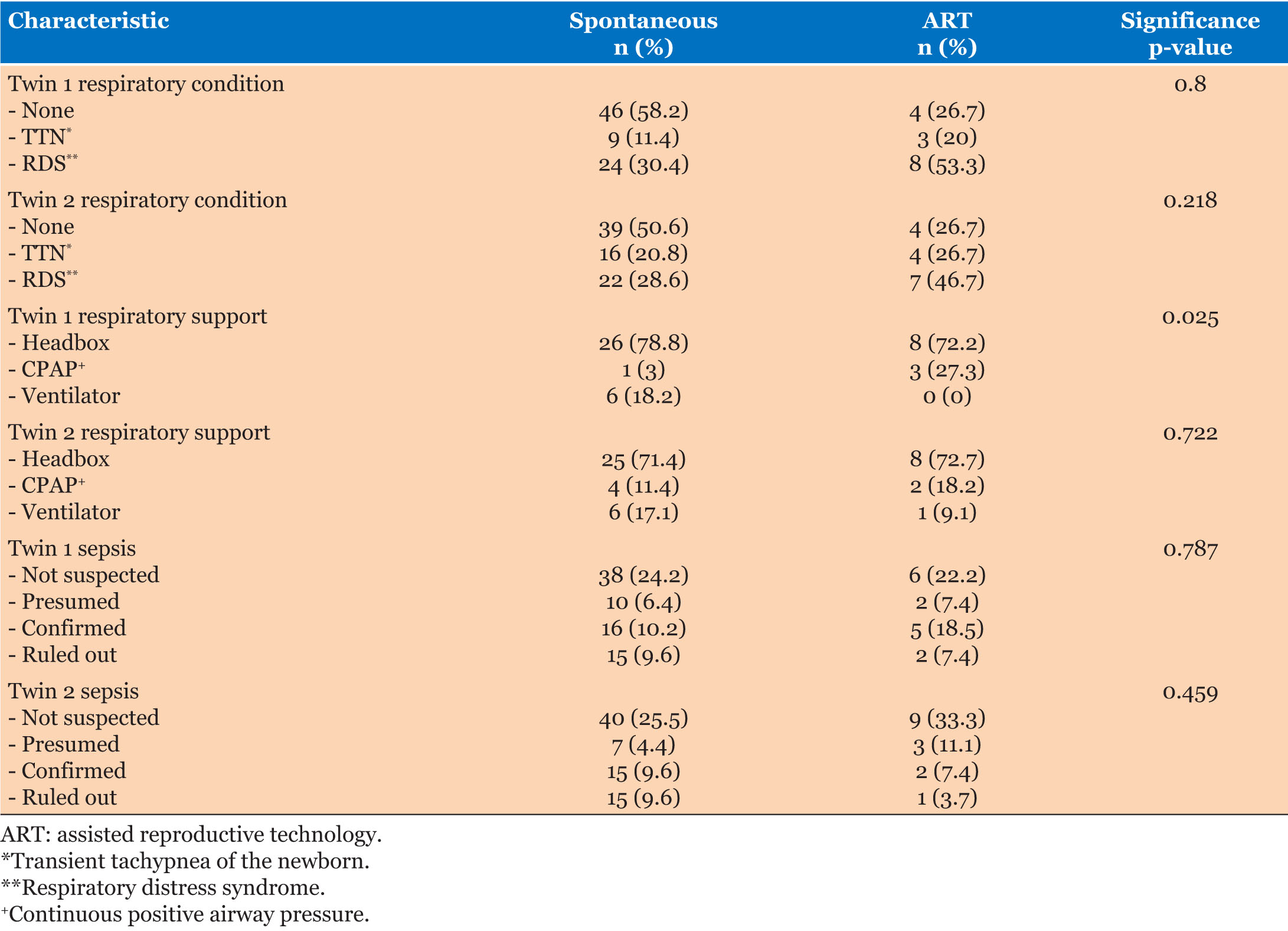 |
Research Article
Complications among assisted reproductive technique (ART) twin gestations versus spontaneously conceived twin gestations (SC): A retrospective outcome analysis among an Afro-Caribbean population at a university-based hospital in Jamaica
1 Department of Obstetrics and Gynecology, University Hospital of the West Indies, Mona, Kingston, Jamaica, West Indies
2 The Hugh Wynter Fertility Management Unit, University of the West Indies, Mona, Kingston, Jamaica, West Indies
3 Cancer Prevention and Control, Ragin Lab, Fox Chase Cancer Center-Temple Health, Young Pavilion, Philadelphia, Pennsylvania, USA
Address correspondence to:
Tracey C Martinborough
MBBS, DM, FACOG, Department of Obstetrics and Gynecology, Child and Adolescent Health, University of the West Indies (Mona), Kingston, Jamaica,
West Indies
Message to Corresponding Author
Article ID: 100013M01GH2024
Access full text article on other devices

Access PDF of article on other devices

How to cite this article
Harrison G, Carroll K, Martinborough TC, Christie L, Harrison S, Wynter S, Rattray C. Complications among assisted reproductive technique (ART) twin gestations versus spontaneously conceived twin gestations (SC): A retrospective outcome analysis among an Afro-Caribbean population at a university-based hospital in Jamaica. Edorium J Matern Child Health 2024;8(2):12–20.ABSTRACT
Aim: The aim of the study is to compare the frequency of maternal and neonatal complications among pregnant women with twin pregnancies conceived spontaneously versus conceived by assisted reproductive technique (ART).
Methods: Univariate and bivariate analyses of maternal characteristics and neonatal outcomes were performed in this retrospective cohort study at a university-based hospital between 2006 and 2016 in Jamaica, a middle-income Caribbean country. Neonatal data were the primary outcomes: APGAR scores, gestational age, birth weight, admission to the neonatal intensive care unit (NICU), and the level of ventilatory support required. Maternal characteristics, comorbidities, and pregnancy complications were other outcomes studied.
Results: There were 157 SC and 27 ART twin gestations. Women conceiving via ART were more likely to be advanced maternal age (p<0.001), have uterine fibroids (p<0.001), previous myomectomy (p=0.001), and incompetent cervix (p=0.003), delivery by cesarean section (p=0.007), and experience hemorrhage (p=0.017) than SC. There were no statistically significant differences in rates of preterm births, birth weight, APGAR scores, or NICU admissions. Assisted reproductive technique twins were more likely to require continuous positive airway pressure (CPAP) (p=0.025), with no differences observed between the two groups for neonatal respiratory distress.
Conclusion: In our predominantly Afro-Caribbean population, ART mothers were observed to have more poor maternal outcomes than mothers who conceived spontaneously. Assisted reproductive technique and SC twins had similar neonatal outcomes; however, ART twins were more likely to require CPAP.
Keywords: ART, Multiple gestation, Spontaneously conceived, Twin
Introduction
A multifetal pregnancy is any pregnancy with a fetal number greater than one, the majority of which are accounted for by twins and, to a lesser extent, triplets [1]. The general global trend over the past two decades, as it relates to twinning, is an increase; between 1980 and 2019, there was a 76% rise in twinning from 18.9 to 32.1 per 1000 births with a plateauing from 2015–2019 [2]. This net increased rate can be attributed to the growing trend in women commencing childbearing at an older age and the utilization of assisted reproductive technology (ART) to conceive, both factors known to increase the probability of multifetal gestation [3]. Though the global rate of twin gestations has plateaued with the push toward single embryo transfer (SET) during ART; there remains a disproportionate number of twin births [4]. The more the fetal number, the greater the probability of maternal and fetal morbidity and mortality, necessitating the increased need for surveillance and monitoring by more experienced personnel [5]. Twin gestations are particularly at risk for preterm birth and its sequelae as 20% of twins, compared with 2% of singletons, are delivered before 37 weeks [2],[3],[4],[5],[6].
To date, there is no unanimity in the literature as to the extent to which being an ART twin increases the risk of complications when compared to spontaneously conceived (SC) twins [7],[8],[9]. Maternal risks factors are often marginalized, with neonatal outcomes taking priority [8],[9]. However, pre-existing maternal conditions, such as fibroids having a high prevalence in the Afro-Caribbean population, may complicate the course of treatment in the ART subset [10]. As such, identification of these factors before offering ART may reduce the probability of poor maternal and fetal outcomes, as the path to ART can be tailored to each patient [11].
In Jamaica, similar to other low-resource countries, there has been a steady increase in twin gestations conceived through ART [12]. Twins and their complications confer a heavy financial burden on patients and the health system. Understanding these complications can help to mitigate maternal and perinatal morbidity and mortality. This study aimed to examine the frequency of maternal and neonatal complications in SC twin versus ART twin gestations.
MATERIALS AND METHODS
Setting and design
A retrospective cohort study identifying all primigravid twin deliveries at a university-based hospital between 2006 and 2016 from hospital records was performed. Primigravid twins were selected as a cohort because there was a disproportionate number of primigravid twins in the ART population (77% of the ART group vs. 44% SC). The study population was predominantly of Afro-Caribbean ancestry. Over this period, there were a total of 23,098 deliveries, 408 multifetal gestations, and 391 twins (99% of multiples and 2% of all deliveries). The primigravid subset was 184 (47% of all twin deliveries). The definition of term used was a gestational age greater than 37 completed weeks and preterm, any gestation below 37 completed weeks [6].
Sample
The two groups studied included women who had SC twins and those who conceived twins using ART. In this study, ART techniques were limited to in vitro fertilization (IVF), utilizing either method of insemination [standard insemination or intracytoplasmic sperm injection (ICSI)]. The labor and delivery unit of the hospital also services the patients who conceive via ART. All primigravida women with twin pregnancy whether conceived spontaneously or by IVF, for the period 2006–2016 were included in the study. All primigravid twin gestations included in this analysis were beyond viability. Fetal viability in Jamaica is defined as a gestational age greater than 24 completed weeks or a birth weight greater than or equal to 500 g [13].
Instrument
Data were extracted from the log records of the labor and delivery unit, pediatric nursery, and patient files where necessary. Supplemental data for the ART group was obtained from the patient files at the fertility unit of the same university-based hospital. Information collected included age, parity, plurality, maternal comorbidities, gestational age at delivery, and neonatal outcomes. Neonatal outcome data included APGAR scores, birth weight, admission to the neonatal intensive care unit (NICU), and the level of ventilatory support which was implemented. All data were kept confidential and ethical approval was obtained from the Mona Campus Research Ethics Committee (MCREC).
Statistical analysis
The data were analyzed using Statistical Package for the Social Sciences Version 27.0 (IBM SPSS Inc., Chicago, IL, USA). Univariate (descriptive analyses) and bivariate (associations) analyses were conducted.
Funding
This research received no specific grant from any funding agency in the public, commercial, or not-for-profit sectors.
RESULTS
The study population included 184 primigravid women with twin gestations irrespective of chorionicity, accounting for 100%. There were 23,098 deliveries, 408 were multiples, 391 (2% of all deliveries, 99% of multiples) were twins. The primigravid subset of twins was 184 (47% of all twin deliveries). There were 27 (15%) primigravid twin pregnancies conceived by ART and 157 (75%) in the SC twin group.
Table 1 shows maternal characteristics and antenatal diagnoses. Overall, the ART group had an older patient demographic than the SC group (p<0.001), the former ranging from 29 to 40 years. Additionally, significantly more ART than SC mothers were found to have uterine fibroids (15% vs. 5%, p<0.001), previous myomectomy (15% vs. 1%, p<0.005), and incompetent cervix (11% vs. 0%, p<0.05). In both SC and ART twins, dichorionicity is most prevalent. Comparing the two groups, significantly more twins conceived by ART were dichorionic (61% vs. 85%, p=0.008) and had either antepartum hemorrhage or postpartum hemorrhage (APH/PPH) (12% vs. 30%, p<0.05) (Table 1).
Of the peripartum characteristics, only cesarean section delivery differed significantly between the two groups (62% SC vs. 93% ART, p=0.007) (Table 2). Elective cesarean section was the most common mode of delivery in both groups, with no ART twins undergoing induction of labor. Most ART and SC twins (79% in each group) were preterm deliveries (Table 2).
There was no statistically significant difference between the groups regarding presentation, gender combination, birth weight, APGAR scores at 1 and 5 minutes, and the need for NICU admission (Table 3).
The ART twin subset required more respiratory support, namely continuous positive airway pressure (CPAP) (p=0.025) (Table 4). There were no observed differences regarding the respiratory problem or the presence of sepsis for the two groups (Table 4).
Discussion
Main findings
In this study, when compared to SC twins, ART twins were born to older women with more fibroids, prior myomectomy, and incompetent cervix. There were more cesarean deliveries and a higher incidence of APH/PPH among ART mothers, with no ART gestations who underwent induction of labor. In the ART group, twin was more likely to need CPAP. As dichorionic twins were more common in ART pregnancies, this is in keeping with multiple embryo transfer (MET) [14].
Our ART mothers were older than SC mothers, similar to other reports in North America and Europe [15]. Women choose to delay childbearing until they achieve their desired academic and socioeconomic advancements, among other reasons [16]. These moves toward self-actualization eventually equate to a loss of fertility years. As women age, there is a direct relationship between age, comorbidities, and a concomitant reduction in ovarian reserve and fecundity [17],[18]. Though the age range of the ART population was an older demographic than their SC counterparts; the mean age was well below the 44–45 years age group reported in other regions [2],[15],[16]. This younger cohort reflects the trend seen in the general society, with increasing rates of obesity and ovulatory disorders, specifically polycystic ovarian syndrome [19]. Additionally, a high incidence of pelvic inflammatory disease, endometriosis, and resultant tubal factor infertility is also seen in younger women [20].
Our ART population, which consists of a younger demographic, and the higher incidence of dichorionic, diamniotic twins compared to the literature, can be attributed to our tendency to perform MET. In our setting, failure of an ART cycle has significant financial implications and may in part explain the tendency to deviate toward the upper limit of the American Society for Reproductive Medicine (ASRM) recommendation for cleavage embryo transfers. Our findings support the need to move toward the current guidelines recommending single blastocyst embryo transfer (SBET) for women less than 35 years, to avoid the risks associated with higher-order gestation [21],[22],[23].
The local preference for ART deliveries by or obstetricians is the abdominal route, both for the expectant parents’ peace of mind and to avoid fetal complications during labor. Physician attitude and clinical experience have been shown to influence the mode of delivery with a propensity toward cesarean for multiple pregnancies [24]. A cesarean section rate of 93% in the ART group compared with 62% in the SC group may also be explained by the higher previous myomectomy rates observed. Locally, a trial of labor after myomectomy is not routinely conducted due to concerns about uterine rupture and a paucity of blood product support. This is not unique to our experience, as obstetricians’ preference toward abdominal delivery after myomectomy and ART has also been highlighted in other jurisdictions [25],[26].
There were no observed differences in conditions such as diabetes and hypertension, as found in other studies [1],[7]. However, the ART group demonstrated increased uterine fibroids, higher rates of previous myomectomy, and incompetent cervix. This is of particular significance in the Afro-Caribbean population studied since uterine pathologies such as fibroids are common and associated with pregnancy loss and preterm birth [27]. As such, ART twin pregnancies in the Afro-Caribbean population may be at particular risk and require increased counseling, screening, and monitoring during their pregnancies. This may include but is not limited to more frequent antenatal follow-up and more aggressive correction of anemia in pregnancy when present. Patients who underwent ART are more likely to have had pre-ART uterine surgeries and evaluations such as hysteroscopy, saline infusion sonogram (SIS), hysterosalpingogram (HSG), all of which may require some degree of cervical manipulation [28]. There may also be intrinsic uterine factors that play a role in infertility which may impact on the etiology of infertility, not all being accounted for [28].
The increased APH/PPH observed among ART twins is likely due to the increased incidence of previous myomectomies and/or increased cesarean delivery rates [29]. Researchers have outlined the association between obstetric hemorrhage (PPH in particular), uterine rupture, and uterine atony, consequent to fibroids and uterine scar [30]. Acceptance of these facts informs the need for such patients to be managed in a hospital with available resources such as a maternal high dependency unit or intensive care unit and readily accessible blood products.
Notwithstanding, other than finding an increased need for CPAP in the ART twin one subset, there was no substantial difference in the neonatal outcomes seen between the two groups. Having a neonatal intensive care unit (NICU) and personnel with advanced training at this institution is likely to have played a significant role in this finding [31],[32]. Conversely, other studies have demonstrated a difference between ART and SC in neonatal outcomes, with the ART group having more respiratory distress syndrome, apnea of prematurity, and patent ductus arteriosus [1]. Despite continuing improvements at our institution, the morbidity for very preterm neonates is higher than in first-world settings; this may influence the absence of disparity within the group analysis [33].
Strengths and limitations
The retrospective design of our study was a limitation, impacting accurate diagnosis of incompetent cervix as sonographic correlation was not always available or documented. However, regardless of the retrospective nature of the study, other relevant clinical information required was available. Compared to other similarly designed studies, our sample size is small, especially regarding the ART groups; however, this was in keeping with the small ART program run locally. Further to this, there was no stratification within the ART group for age. Another limitation of this study is that only pregnancies beyond viability were included; thus, first and early second trimester losses were not reviewed. Yet another limitation includes the fact that p values have been used throughout the manuscript; however, confidence interval is much better to give idea about the spectrum of the significance.
Despite the limitations, there were strengths to our study. To our knowledge, this is the first study examining the frequency of complications in SC twin gestations versus ART twins in a predominantly Afro-Caribbean population. Our tertiary-level institution accepts multiple gestation referrals from across Jamaica; therefore, the data adequately reflects the general population. Additionally, with the ART center attached to this hospital, those deliveries resulting from ART are conducted at this institution.
Interpretation
Prospective studies have mirrored our findings, demonstrating higher rates of NICU admission and preterm birth in twins conceived via ART versus SC [7]. Nonetheless, the overall adverse maternal and perinatal risks have proven to be low; providing reassurance to ART subscribers and underscoring the importance of high-risk antenatal care to minimize these risks [34].
Conclusion
In our predominantly Afro-Caribbean population, ART mothers were observed to have more poor maternal outcomes than mothers who conceived spontaneously. Consequently, preconception counseling is important for all patients, especially those presenting with complicated gynecological histories, to identify and institute interventions to mitigate risks. This is paramount since our ART sample population were older mothers with a history of uterine fibroids, previous myomectomy, and cervical incompetence. Additionally, the thrust toward single embryo transfer (SET) should continue, which may be of particular benefit to populations of Afro-Caribbean descent in reducing the rate of twinning. Assisted reproductive technique and SC twins had similar neonatal outcomes; however, ART twins were more likely to require CPAP. Overall, our findings suggest that despite the disparity in complications, the outcomes were comparative for ART and SC twins once adequate obstetric and pediatric support in a tertiary institution. Recommended research areas include prospective studies of ART gestations looking at positive pregnancy rates, rates of twinning, and overall outcomes in ART pregnancy regardless of gestational age. Additionally, prospective studies are needed to elucidate how the various classification of fibroids impact pregnancy outcomes in twin gestations.
REFERENCES
1.
Caserta D, Bordi G, Stegagno M, et al. Maternal and perinatal outcomes in spontaneous versus assisted conception twin pregnancies. Eur J Obstet Gynecol Reprod Biol 2014;174:64–9. [CrossRef]
[Pubmed]

2.
Martin JA, Hamilton BE, Osterman MJK, Driscoll AK. Births: Final data for 2019. Natl Vital Stat Rep 2021;70(2):1–51.
[Pubmed]

3.
Blondel B, Kaminski M. Trends in the occurrence, determinants, and consequences of multiple births. Semin Perinatol 2002;26(4):239–49. [CrossRef]
[Pubmed]

4.
Takehara I, Takahashi T, Hara S, Matsuo K, Igarashi H, Kurachi H. Dizygotic twin pregnancy after single embryo transfer: A case report and review of the literature. J Assist Reprod Genet 2014;31(4):443–6. [CrossRef]
[Pubmed]

5.
Syed NR. O667 increased maternal morbidity and adverse perinatal outcome with twin pregnancy. Int J Gynaecol Obstet 2012;119(S3):S495. [CrossRef]

6.
Goldenberg RL, Culhane JF, Iams JD, Romero R. Epidemiology and causes of preterm birth. Lancet 2008;371(9606):75–84. [CrossRef]
[Pubmed]

7.
Moini A, Shiva M, Arabipoor A, Hosseini R, Chehrazi M, Sadeghi M. Obstetric and neonatal outcomes of twin pregnancies conceived by assisted reproductive technology compared with twin pregnancies conceived spontaneously: A prospective follow-up study. Eur J Obstet Gynecol Reprod Biol 2012;165(1):29–32. [CrossRef]
[Pubmed]

8.
Qin JB, Wang H, Sheng X, Xie Q, Gao S. Assisted reproductive technology and risk of adverse obstetric outcomes in dichorionic twin pregnancies: A systematic review and meta-analysis. Fertil Steril 2016;105(5):1180–92. [CrossRef]
[Pubmed]

9.
Wang AY, Safi N, Ali F, et al. Neonatal outcomes among twins following assisted reproductive technology: An Australian population-based retrospective cohort study. BMC Pregnancy Childbirth 2018;18(1):320. [CrossRef]
[Pubmed]

10.
Goeckenjan M, Madej D, Klimova A, Wimberger P, Birdir C, Glaß K. Are two children at once better than one? Risk analysis of twin pregnancies and births after assisted reproduction. Eur J Obstet Gynecol Reprod Biol 2021;264:76–82. [CrossRef]
[Pubmed]

11.
Nekuei N, Kazemi A, Hasanzadeh A. Preconception interventions in infertile couples. J Educ Health Promot 2014;3:101 [CrossRef]
[Pubmed]

12.
13.
14.
Vega M, Zaghi S, Buyuk E, Jindal S. Not all twins are monozygotic after elective single embryo transfer: Analysis of 32,600 elective single embryo transfer cycles as reported to the Society for Assisted Reproductive Technology. Fertil Steril 2018;109(1):118–22. [CrossRef]
[Pubmed]

15.
Ubaldi FM, Cimadomo D, Vaiarelli A, et al. Advanced maternal age in IVF: Still a challenge? The present and the future of its treatment. Front Endocrinol (Lausanne) 2019;10:94. [CrossRef]
[Pubmed]

16.
17.
American College of Obstetricians and Gynecologists Committee on Gynecologic Practice and Practice Committee. Female age-related fertility decline. Committee Opinion No. 589. Fertil Steril 2014;101(3):633–4. [CrossRef]
[Pubmed]

18.
Delbaere I, Verbiest S, Tydén T. Knowledge about the impact of age on fertility: A brief review. Ups J Med Sci 2020;125(2):167–74. [CrossRef]
[Pubmed]

19.
Barua S, Hng TM, Smith H, Bradford J, McLean M. Ovulatory disorders are an independent risk factor for pregnancy complications in women receiving assisted reproduction treatments. Aust N Z J Obstet Gynaecol 2017;57(3):286–93. [CrossRef]
[Pubmed]

20.
Elizur SE, Lebovitz O, Weintraub AY, et al. Pelvic inflammatory disease in women with endometriosis is more severe than in those without. Aust N Z J Obstet Gynaecol 2014;54(2):162–5. [CrossRef]
[Pubmed]

21.
Pierce N, Mocanu E. Female age and assisted reproductive technology. Glob Reprod Health 2018;3(2):e9. [CrossRef]

22.
Tobias T, Sharara FI, Franasiak JM, Heiser PW, Pinckney-Clark E. Promoting the use of elective single embryo transfer in clinical practice. Fertil Res Pract 2016;2:1. [CrossRef]
[Pubmed]

23.
Practice Committee of the American Society for Reproductive Medicine. Electronic address: ASRM@ asrm.org; Practice Committee of the Society for Assisted Reproductive Technology. Guidance on the limits to the number of embryos to transfer: A committee opinion. Fertil Steril 2017;107(4):901–3. [CrossRef]
[Pubmed]

24.
Vallejos Parás A, Espino Y Sosa S, Betancourt JL, et al. Obstetrician’s attitudes about delivery through cesarean section: A study in hospitals at Mexico City. Perinatología y Reproducción Humana 2018;32:19–26. [CrossRef]

25.
Weibel HS, Jarcevic R, Gagnon R, Tulandi T. Perspectives of obstetricians on labour and delivery after abdominal or laparoscopic myomectomy. J Obstet Gynaecol Can 2014;36(2):128–32. [CrossRef]
[Pubmed]

26.
Antsaklis A, Malamas FM, Sindos M. Trends in twin pregnancies and mode of delivery during the last 30 years: Inconsistency between guidelines and clinical practice. J Perinat Med 2013;41(4):355–64. [CrossRef]
[Pubmed]

27.
Stewart EA, Nicholson WK, Bradley L, Borah BJ. The burden of uterine fibroids for African-American women: Results of a national survey. J Womens Health (Larchmt) 2013;22(10):807–16. [CrossRef]

28.
Bakas P, Hassiakos D, Grigoriadis C, Vlahos N, Liapis A, Gregoriou O. Role of hysteroscopy prior to assisted reproduction techniques. J Minim Invasive Gynecol 2014;21(2):233–7. [CrossRef]
[Pubmed]

29.
Milazzo GN, Catalano A, Badia V, Mallozzi M, Caserta D. Myoma and myomectomy: Poor evidence concern in pregnancy. J Obstet Gynaecol Res 2017;43(12):1789–804. [CrossRef]
[Pubmed]

30.
Liu CN, Yu FB, Xu YZ, et al. Prevalence and risk factors of severe postpartum hemorrhage: A retrospective cohort study. BMC Pregnancy Childbirth 2021;21(1):332. [CrossRef]
[Pubmed]

31.
Ho CH, Peng FS, Chen HF, Lien YR, Chen SU, Yang YS. Twin pregnancies conceived by assisted reproductive technology: Maternal and perinatal outcomes. Taiwanese J Obstet Gynecol 2005;44(4):332–7. [CrossRef]

32.
33.
Trotman H, Barton M, Mitchell V. Outcome of neonates ventilated in the main intensive care unit at The University Hospital of the West Indies: A 15-year experience. Trop Doct 2007;37(4):249–50. [CrossRef]
[Pubmed]

34.
Arian SE, Erfani H, Yadav GS, Clark S, Gibbons WE, Shamshirsaz AA. Neonatal and maternal outcomes among twin pregnancies stratified by mode of conception in the United States. Fertil Steril 2021;116(2):514–21. [CrossRef]
[Pubmed]

SUPPORTING INFORMATION
Author Contributions
Giselle Harrison - Conception of the work, Design of the work, Acquisition of data, Analysis of data, Drafting the work, Revising the work critically for important intellectual content, Final approval of the version to be published, Agree to be accountable for all aspects of the work in ensuring that questions related to the accuracy or integrity of any part of the work are appropriately investigated and resolved.
Kamali Carroll - Conception of the work, Design of the work, Acquisition of data, Drafting the work, Revising the work critically for important intellectual content, Final approval of the version to be published, Agree to be accountable for all aspects of the work in ensuring that questions related to the accuracy or integrity of any part of the work are appropriately investigated and resolved.
Tracey C Martinborough - Acquisition of data, Analysis of data, Drafting the work, Revising the work critically for important intellectual content, Final approval of the version to be published, Agree to be accountable for all aspects of the work in ensuring that questions related to the accuracy or integrity of any part of the work are appropriately investigated and resolved.
Loxley Christie - Acquisition of data, Drafting the work, Final approval of the version to be published, Agree to be accountable for all aspects of the work in ensuring that questions related to the accuracy or integrity of any part of the work are appropriately investigated and resolved.
Sharon Harrison - Conception of the work, Design of the work, Acquisition of data, Analysis of data, Drafting the work, Final approval of the version to be published, Agree to be accountable for all aspects of the work in ensuring that questions related to the accuracy or integrity of any part of the work are appropriately investigated and resolved.
Shaun Wynter - Conception of the work, Design of the work, Analysis of data, Drafting the work, Final approval of the version to be published, Agree to be accountable for all aspects of the work in ensuring that questions related to the accuracy or integrity of any part of the work are appropriately investigated and resolved.
Carole Rattray - Conception of the work, Design of the work, Acquisition of data, Analysis of data, Drafting the work, Revising the work critically for important intellectual content, Final approval of the version to be published, Agree to be accountable for all aspects of the work in ensuring that questions related to the accuracy or integrity of any part of the work are appropriately investigated and resolved.
Guaranter of SubmissionThe corresponding author is the guarantor of submission.
Source of SupportNone
Consent StatementWritten informed consent was obtained from the patient for publication of this article.
Data AvailabilityAll relevant data are within the paper and its Supporting Information files.
Conflict of InterestAuthors declare no conflict of interest.
Copyright© 2024 Giselle Harrison et al. This article is distributed under the terms of Creative Commons Attribution License which permits unrestricted use, distribution and reproduction in any medium provided the original author(s) and original publisher are properly credited. Please see the copyright policy on the journal website for more information.









